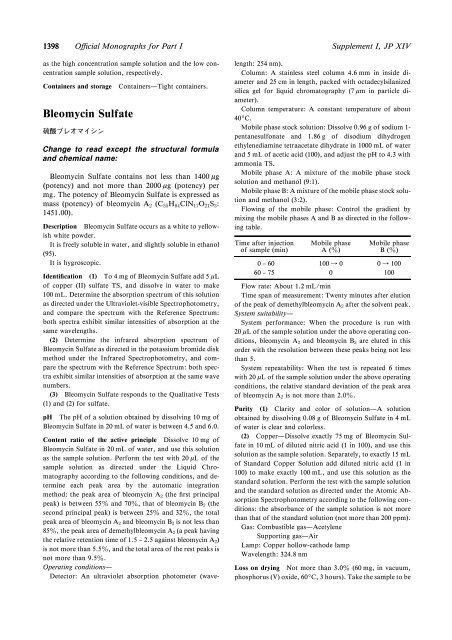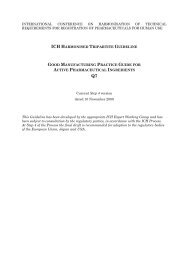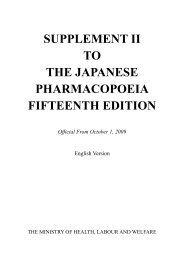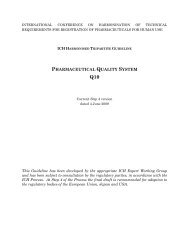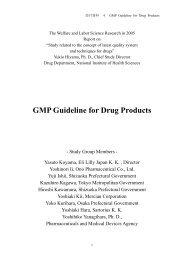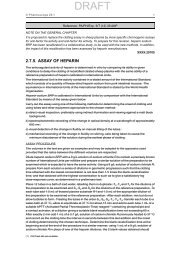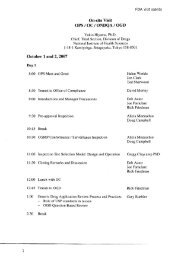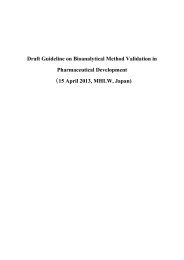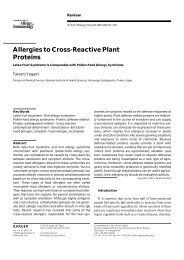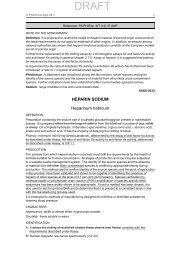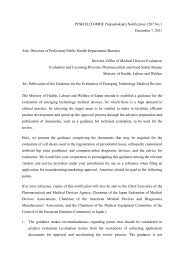Supplement I to the Japanese Pharmacopoeia Fourteenth Edition
Supplement I to the Japanese Pharmacopoeia Fourteenth Edition
Supplement I to the Japanese Pharmacopoeia Fourteenth Edition
Create successful ePaper yourself
Turn your PDF publications into a flip-book with our unique Google optimized e-Paper software.
1398 O‹cial Monographs for Part I<br />
<strong>Supplement</strong> I, JP XIV<br />
as <strong>the</strong> high concentration sample solution and <strong>the</strong> low concentration<br />
sample solution, respectively.<br />
Containers and s<strong>to</strong>rage<br />
Bleomycin Sulfate<br />
硫 酸 ブレオマイシン<br />
Containers—Tight containers.<br />
Change <strong>to</strong> read except <strong>the</strong> structural formula<br />
and chemical name:<br />
Bleomycin Sulfate contains not less than 1400 mg<br />
(potency) and not more than 2000 mg (potency) per<br />
mg. The potency of Bleomycin Sulfate is expressed as<br />
mass (potency) of bleomycin A 2 (C 55 H 84 ClN 17 O 21 S 3 :<br />
1451.00).<br />
Description Bleomycin Sulfate occurs as a white <strong>to</strong> yellowish<br />
white powder.<br />
It is freely soluble in water, and slightly soluble in ethanol<br />
(95).<br />
It is hygroscopic.<br />
Identiˆcation (1) To 4 mg of Bleomycin Sulfate add 5 mL<br />
of copper (II) sulfate TS, and dissolve in water <strong>to</strong> make<br />
100 mL. Determine <strong>the</strong> absorption spectrum of this solution<br />
as directed under <strong>the</strong> Ultraviolet-visible Spectropho<strong>to</strong>metry,<br />
and compare <strong>the</strong> spectrum with <strong>the</strong> Reference Spectrum:<br />
both spectra exhibit similar intensities of absorption at <strong>the</strong><br />
same wavelengths.<br />
(2) Determine <strong>the</strong> infrared absorption spectrum of<br />
Bleomycin Sulfate as directed in <strong>the</strong> potassium bromide disk<br />
method under <strong>the</strong> Infrared Spectropho<strong>to</strong>metry, and compare<br />
<strong>the</strong> spectrum with <strong>the</strong> Reference Spectrum: both spectra<br />
exhibit similar intensities of absorption at <strong>the</strong> same wave<br />
numbers.<br />
(3) Bleomycin Sulfate responds <strong>to</strong> <strong>the</strong> Qualitative Tests<br />
(1)and(2)forsulfate.<br />
pH The pH of a solution obtained by dissolving 10 mg of<br />
Bleomycin Sulfate in 20 mL of water is between 4.5 and 6.0.<br />
Content ratio of <strong>the</strong> active principle Dissolve 10 mg of<br />
Bleomycin Sulfate in 20 mL of water, and use this solution<br />
as <strong>the</strong> sample solution. Perform <strong>the</strong> test with 20 mL of<strong>the</strong><br />
sample solution as directed under <strong>the</strong> Liquid Chroma<strong>to</strong>graphy<br />
according <strong>to</strong> <strong>the</strong> following conditions, and determine<br />
each peak area by <strong>the</strong> au<strong>to</strong>matic integration<br />
method: <strong>the</strong> peak area of bleomycin A 2 (<strong>the</strong> ˆrst principal<br />
peak) is between 55z and 70z, tha<strong>to</strong>fbleomycinB 2 (<strong>the</strong><br />
second principal peak) is between 25z and 32z, <strong>the</strong> <strong>to</strong>tal<br />
peak area of bleomycin A 2 and bleomycin B 2 is not less than<br />
85z, <strong>the</strong> peak area of demethylbleomycin A 2 (a peak having<br />
<strong>the</strong> relative retention time of 1.5 – 2.5 against bleomycin A 2 )<br />
is not more than 5.5z, and <strong>the</strong> <strong>to</strong>tal area of <strong>the</strong> rest peaks is<br />
not more than 9.5z.<br />
Operating conditions—<br />
Detec<strong>to</strong>r: An ultraviolet absorption pho<strong>to</strong>meter (wavelength:<br />
254 nm).<br />
Column: A stainless steel column 4.6 mm in inside diameter<br />
and 25 cm in length, packed with octadecylsilanized<br />
silica gel for liquid chroma<strong>to</strong>graphy (7 mm in particle diameter).<br />
Column temperature: A constant temperature of about<br />
409C.<br />
Mobile phase s<strong>to</strong>ck solution: Dissolve 0.96 g of sodium 1-<br />
pentanesulfonate and 1.86 g of disodium dihydrogen<br />
ethylenediamine tetraacetate dihydrate in 1000 mL of water<br />
and 5 mL of acetic acid (100), and adjust <strong>the</strong> pH <strong>to</strong> 4.3 with<br />
ammonia TS.<br />
Mobile phase A: A mixture of <strong>the</strong> mobile phase s<strong>to</strong>ck<br />
solution and methanol (9:1).<br />
Mobile phase B: A mixture of <strong>the</strong> mobile phase s<strong>to</strong>ck solution<br />
and methanol (3:2).<br />
Flowing of <strong>the</strong> mobile phase: Control <strong>the</strong> gradient by<br />
mixing <strong>the</strong> mobile phases A and B as directed in <strong>the</strong> following<br />
table.<br />
Time after injection<br />
of sample (min)<br />
Mobile phase<br />
A(z)<br />
Mobile phase<br />
B(z)<br />
0–60 100→ 0 0 → 100<br />
60–75 0 100<br />
Flow rate: About 1.2 mL/min<br />
Time span of measurement: Twenty minutes after elution<br />
of <strong>the</strong> peak of demethylbleomycin A 2 after <strong>the</strong> solvent peak.<br />
System suitability—<br />
System performance: When <strong>the</strong> procedure is run with<br />
20 mL of <strong>the</strong> sample solution under <strong>the</strong> above operating conditions,<br />
bleomycin A 2 and bleomycin B 2 areelutedinthis<br />
order with <strong>the</strong> resolution between <strong>the</strong>se peaks being not less<br />
than 5.<br />
System repeatability: When <strong>the</strong> test is repeated 6 times<br />
with 20 mL of <strong>the</strong> sample solution under <strong>the</strong> above operating<br />
conditions, <strong>the</strong> relative standard deviation of <strong>the</strong> peak area<br />
of bleomycin A 2 is not more than 2.0z.<br />
Purity (1) Clarity and color of solution—A solution<br />
obtained by dissolving 0.08 g of Bleomycin Sulfate in 4 mL<br />
of water is clear and colorless.<br />
(2) Copper—Dissolve exactly 75 mg of Bleomycin Sulfatein10mLofdilutednitricacid(1in100),andusethis<br />
solution as <strong>the</strong> sample solution. Separately, <strong>to</strong> exactly 15 mL<br />
of Standard Copper Solution add diluted nitric acid (1 in<br />
100) <strong>to</strong> make exactly 100 mL, and use this solution as <strong>the</strong><br />
standard solution. Perform <strong>the</strong> test with <strong>the</strong> sample solution<br />
and <strong>the</strong> standard solution as directed under <strong>the</strong> A<strong>to</strong>mic Absorption<br />
Spectropho<strong>to</strong>metry according <strong>to</strong> <strong>the</strong> following conditions:<br />
<strong>the</strong> absorbance of <strong>the</strong> sample solution is not more<br />
than that of <strong>the</strong> standard solution (not more than 200 ppm).<br />
Gas: Combustible gas—Acetylene<br />
Supporting gas—Air<br />
Lamp: Copper hollow-cathode lamp<br />
Wavelength: 324.8 nm<br />
Loss on drying Not more than 3.0z (60 mg, in vacuum,<br />
phosphorus (V) oxide, 609C, 3 hours). Take <strong>the</strong> sample <strong>to</strong> be


